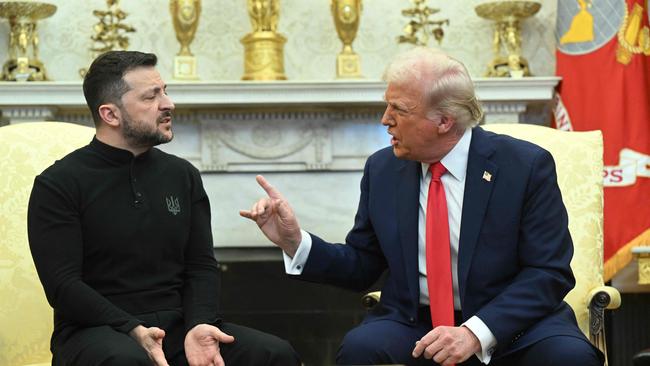Minerals deal a breakthrough moment for Trump
The signing of a sought after minerals deal is a breakthrough moment for Donald Trump in the turbulent relationship between Washington and Kyiv.

The signing of a deal granting America access to Ukraine’s mineral wealth is a breakthrough moment and follows a period of heightened turbulence over Donald Trump’s bid to end the war in Eastern Europe.
US relations with Kyiv had slumped to a historic low point when the US President, on February 28, publicly berated Volodymyr Zelensky in the Oval Office in scenes never before captured by the world’s media.
This was the culmination of deep personal and political tensions that escalated swiftly after Mr Trump took office on January 20 after he promised during the campaign to end the war within 24 hours – a timeline from which he later retreated.
On February 12, Mr Trump commenced his diplomatic campaign to end the conflict by speaking with Vladimir Putin over the phone. The US President engaged the Russian leader first, before speaking with Mr Zelensky. This gave rise to fears the US President was sympathetic to Russia and could insist on a deal to end the conflict on Moscow’s terms.
While the US President went on to brief Mr Zelensky on his phone call, Mr Trump’s re-engagement with and international rehabilitation of Mr Putin marked a departure in US foreign policy.
US Defence Secretary Pete Hegseth also told a meeting of Ukraine Defence Contact Group in Brussels on February 12 that America did not believe NATO membership was a realistic outcome for Kyiv. He suggested that returning to Ukraine’s pre-2014 borders was off the table.
Drawing a line in the sand, Mr Zelensky declared “nothing about Ukraine can be decided without Ukraine”, as America pressed ahead with diplomatic talks with Russian officials in Saudi Arabia on February 18.
No breakthrough was secured, but the exclusion of Ukraine was a point of frustration for Mr Zelensky. Mr Trump hit back at the Ukrainian leader during a press conference in Mar-a-Lago, implying that Kyiv was responsible for the conflict. “Well, you’ve been there for three years. You should’ve ended it after three years. You should’ve never started it. You could’ve made a deal,” he said.
The extraordinary accusation on February 18 came at the same time the US was trying to secure Kyiv’s agreement for a possible deal giving Washington access to up to $US500bn in critical minerals as a form of compensation for supporting the war effort.
Treasury Secretary Scott Bessent had tried to secure Mr Zelensky’s support for the agreement on a trip to Ukraine earlier in the month, but had been rebuffed. The Ukrainian leader informed Mr Bessent on February 12 that he wanted a security guarantee against future Russian aggression.
The rift between Mr Trump and Mr Zelensky deepened towards the end of February. The US President accused the Ukrainian leader on February 19 of being a “dictator without elections” and criticised him for not holding a national poll during the war.
Mr Zelensky said the US President was living in a Russian “disinformation bubble”.
The relationship hit a new low at the end of February when Mr Zelensky travelled to Washington but found himself in a public argument with Mr Trump and Vice-President JD Vance in the Oval Office. “You’ve got to be more thankful,” Mr Trump told him. “You don’t have the cards.”
On March 5, less than a week after the Oval Office blow-up, the US ceased intelligence sharing with Ukraine, including targeting data for long-range missile strikes. The decision left the war-torn nation significantly more vulnerable to Russian attacks.
Sharing recommenced several days later after Ukraine agreed in principle to a US ceasefire proposal, which Mr Putin was briefed about on March 13. While a 30-day energy infrastructure ceasefire began at the end of March, a more permanent agreement has proved elusive.
A key turning point came on April 26 when Mr Trump and Mr Zelensky met privately at St Peter’s Basilica on the margins of the funeral for Pope Francis – enabling them to reset relations.
This provided a renewed sense of diplomatic momentum to advance the minerals deal, and gave Mr Zelensky another chance to shift the US President’s thinking about Mr Putin and focus on reprioritising a full and unconditional ceasefire.
Mr Trump went on to post on his social media account that he suspected the Russian leader was not serious about peace. “It makes me think that maybe he doesn’t want to stop the war, he’s just tapping me along and has to be dealt with differently,” he said.
Four days later, the Trump administration had clinched its deal with Ukraine for a new “Reconstruction Investment Fund”, allowing the US access to the nation’s mineral wealth.
It was framed by Mr Bessent as a key step towards ending the “cruel and senseless war” in Eastern Europe and a meaningful commitment by Washington to Ukrainian security.
“This agreement signals clearly to Russia that the Trump administration is committed to a peace process centred on a free, sovereign and prosperous Ukraine over the long term,” he said.




To join the conversation, please log in. Don't have an account? Register
Join the conversation, you are commenting as Logout